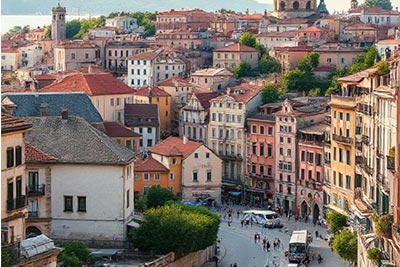Terme di Sciacca
Sciacca
Terme di Sciacca
Terme di Sciacca S.p.A. offers high-quality thermal treatments, panoramic pools, and conference services in a location overlooking the Mediterranean.
- Terme di Sciacca: a millennial thermal heritage: The Terme di Sciacca have been known since ancient times for their thermal waters with therapeutic properties, used for centuries for well-being and the treatment of various ailments.
- The 'Stufe di San Calogero': natural steam caves: The 'Stufe di San Calogero' are two natural caves located on Mount Kronio, known for their steam emissions that offer a unique therapeutic experience.
- The Castello dei Luna: historical testimony of Sciacca: The Castello dei Luna, built by the Normans in the 13th century, dominates the historic center of Sciacca and offers panoramic views of the city and the sea.
General Information
Terme di Sciacca S.p.A. is a major thermal spa located in Sciacca, in the province of Agrigento, Sicily. The thermal complex is immersed in a park overlooking the Mediterranean, providing a relaxing atmosphere among the greenery of the gardens and the blue of the sea. Facilities include thermal pools, thermal treatment departments, and conference services, all designed to guarantee a high quality and organizational standard.
The thermal park of Sciacca is famous for its thermal waters and muds, which are considered among the most effective in the world. The thermal springs and caves with therapeutic properties can help slow the progression of chronic diseases and combat stress. The thermal waters of Sciacca are classified as saline-bromine-iodine and sulfuric, with a high mineral content, making them effective for treatments against respiratory, rheumatic, dermatological, and gynecological diseases.
History
The origins of Terme di Sciacca date back to antiquity. The Greeks of Selinunte were among the first to use the thermal waters of the area, recognizing their healing properties. Subsequently, the Romans further developed the therapeutic use of the waters, making Sciacca a renowned thermal spa.
During the Middle Ages, the arrival of San Calogero marked a new phase for the spas. The saint used the steamy caves to treat rheumatic and respiratory diseases, solidifying the reputation of Sciacca's thermal waters. The city itself likely owes its name to the Arabs, who called it 'Syakk', meaning bath.
In the Renaissance, doctors and scholars described the virtues of the waters of Sciacca, attracting the attention of visitors and researchers. In the 19th century, modern establishments began to be built, including the complex of the Nuove Terme, built in the 1930s in Liberty style, which is still a landmark for Sicilian thermalism.
Therapeutic Information on the Waters
The thermal waters of Sciacca derive from the underground volcanic activity of the area. Currently, there are five main springs active: the Acqua dei Molinelli, the Acqua Santa, and the Acqua Sulfurea. These waters are classified as saline-bromine-iodine and sulfuric, with a high mineral content, making them effective for treatments against respiratory, rheumatic, dermatological, and gynecological diseases.
The Acqua dei Molinelli is a hypothermal saline-bromine-iodine water that flows at a temperature of 34 °C. It is indicated for dermatological issues and is also used for diseases of the respiratory system, female reproductive system, musculoskeletal system, and for vascular diseases. The waters flow into the thermal basins of the Molinelli, a complex of pools built in the early 1990s.
The Acqua Sulfurea, located in the 'Valley of Baths', flows at a temperature of 56 °C and is used for thermal treatments. It is indicated for diseases of the respiratory system, ear, nose, and throat, as well as for skin diseases, but it is mainly used for mud therapy. A particular type of clay is soaked in this sulfuric water in large basins for at least six months; this creates a thermal mud with anti-rheumatic therapeutic properties.
The Acqua Santa is the oldest water of the thermal basin. It is a saline-iodine-sulfate-alkaline-ferrous water and is indicated for the digestive system, with strong diuretic and laxative properties.
Treatments and Therapies
Terme di Sciacca offers a wide range of therapeutic treatments, including mud therapy, balneotherapy, inhalations, and anthrotherapy in the steam caves. Mud therapy uses thermal mud derived from the Acqua Sulfurea, applied to the affected area at a temperature of about 38 °C, followed by a beneficial sweating reaction. Balneotherapy involves immersion in sulfurous water pools at a temperature of about 37 °C for 5/10 minutes, used to treat diseases of the musculoskeletal system thanks to its anti-inflammatory properties.
Thermal inhalations are used to treat respiratory system diseases, exploiting the therapeutic properties of the sulfurous waters. Anthrotherapy, or sweating therapy, is conducted in the steam caves of Mount Kronio, where the atmosphere saturated with water vapor and sulfur gas, with temperatures reaching 38/41 °C and humidity around 95%, promotes sweating and muscle relaxation, contributing to the treatment of inflammatory conditions in the upper respiratory tract.
In addition to thermal treatments, Terme di Sciacca offers physiotherapy and rehabilitation services, with cutting-edge therapeutic and diagnostic equipment. The physiotherapy and rehabilitation department is active all year round, providing advanced therapeutic techniques for functional recovery and patient well-being.
Features
- Thermal treatments: Thermal waters and muds offer therapeutic properties for various medical conditions.
- Thermal pools: Pools fed with sulfurous water, located in a panoramic position overlooking the sea.
- Rehabilitative treatments: Physiotherapy and rehabilitation services for physical recovery and well-being.
Location
The spa Terme di Sciacca is located in Sciacca in Italia.Indirizzo: Via Agatocle, 2, 92019 Sciacca (Sicilia) - Italia

Things to do near Terme di Sciacca
* Le informazioni sono state ricavate da fonti pubbliche e potrebbero non essere aggiornate. RelaxAtlas non è responsabile per eventuali errori o omissioni.
